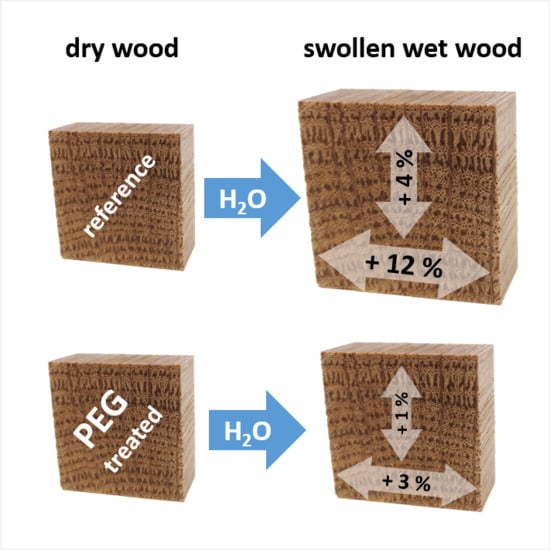Suitability of Different Variants of Polyethylene Glycol Impregnation for the Dimensional Stabilization of Oak Wood
Abstract
:1. Introduction
2. Materials and Methods
2.1. Wood Material and Treatment
2.2. Determination of Anti-Shrinkage Efficiency (ASE)
2.3. Scanning Electron Microscopy (SEM)
2.4. Statistical Analysis
3. Results and Discussion
3.1. Effect of Impregnation on Specimen Mass and Water Relations
3.2. Dimensional Stabilization
4. Conclusions
- Beside the classical long-term diffusion approach, fast vacuum-pressure impregnation is suitable for PEG impregnation of European oak wood, as shown earlier for red pine. Significant reductions in swelling upon moisture uptake were achieved compared to untreated specimens, even though PEG impregnation resulted in above-reference equilibrium moisture content.
- Silane-functional PEG generally showed poorer performance compared to unmodified PEG, with the exception of leaching, where PEG-silane proved more recalcitrant than PEG and therefore demands deeper attention in further work to overcome unmodified PEG disadvantages.
- Dimensional stabilization was predominantly achieved in oak earlywood, which resulted in dimensional stabilization only in radial anatomical direction, whereas the tangential dimensional stability remained unaffected by impregnation.
- The suitability of the method for the bigger scale specimens needs to be proven in future as the next step towards industrial application.
Acknowledgments
Author Contributions
Conflicts of Interest
References
- Klein, A.; Bockhorn, O.; Mayer, K.; Grabner, M. Central European wood species: Characterization using old knowledge. J. Wood Sci. 2016, 62, 194–202. [Google Scholar] [CrossRef]
- Norimoto, M.; Gril, J. Structure and properties of chemically treated woods. In Recent Research on Wood and Wood-Based Materials; Shiraishi, N., Kajita, H., Norimoto, M., Eds.; Elsevier: Barking, UK, 1993; pp. 135–154. [Google Scholar]
- Hill, C.A. Wood Modification: Chemical, Thermal and Other Processes; John Wiley & Sons: Hoboken, NJ, USA, 2006; Volume 5. [Google Scholar]
- Kocaefe, D.; Huang, X.; Kocaefe, Y. Dimensional stabilization of wood. Curr. For. Rep. 2015, 1, 151–161. [Google Scholar] [CrossRef]
- Lesar, B.; Pavlič, M.; Petrič, M.; Škapin, A.S.; Humar, M. Wax treatment of wood slows photodegradation. Polym. Degrad. Stab. 2011, 96, 1271–1278. [Google Scholar] [CrossRef]
- Scholz, G.; Krause, A.; Militz, H. Exploratory study on the impregnation of scots pine sapwood (Pinus sylvestris L.) and European beech (Fagus sylvatica L.) with different hot melting waxes. Wood Sci. Technol. 2010, 44, 379–388. [Google Scholar] [CrossRef]
- Gindl, W.; Gupta, H. Cell-wall hardness and young’s modulus of melamine-modified spruce wood by nano-indentation. Compos. A 2002, 33, 1141–1145. [Google Scholar] [CrossRef]
- Deka, M.; Gindl, W.; Wimmer, R.; Hansmann, C. Chemical modification of Norway spruce (Picea abies (L.) Karst) wood with melamine formaldehyde resin. Indian J. Chem. Technol. 2007, 14, 134–138. [Google Scholar]
- Gindl, W.; Hansmann, C.; Gierlinger, N.; Schwanninger, M.; Hinterstoisser, B.; Jeronimidis, G. Using a water-soluble melamine-formaldehyde resin to improve the hardness of Norway spruce wood. J. Appl. Polym. Sci. 2004, 93, 1900–1907. [Google Scholar] [CrossRef]
- Deka, M.; Saikia, C. Chemical modification of wood with thermosetting resin: Effect on dimensional stability and strength property. Bioresour. Technol. 2000, 73, 179–181. [Google Scholar] [CrossRef]
- Alma, M.; Hafizo lu, H.; Maldas, D. Dimensional stability of several wood species treated with vinyl monomers and polyethylene glycol-1000. Int. J. Polym. Mater. 1996, 32, 93–99. [Google Scholar] [CrossRef]
- Donath, S.; Militz, H.; Mai, C. Wood modification with alkoxysilanes. Wood Sci. Technol. 2004, 38, 555–566. [Google Scholar] [CrossRef]
- Mai, C.; Militz, H. Modification of wood with silicon compounds. Treatment systems based on organic silicon compounds—A review. Wood Sci. Technol. 2004, 37, 453–461. [Google Scholar] [CrossRef]
- Sèbe, G.; Brook, M.A. Hydrophobization of wood surfaces: Covalent grafting of silicone polymers. Wood Sci. Technol. 2001, 35, 269–282. [Google Scholar] [CrossRef]
- Pries, M.; Wagner, R.; Kaesler, K.-H.; Militz, H.; Mai, C. Effect of short-chain silicones bearing different functional groups on the resistance of pine (Pinus sylvestris L.) and beech (Fagus sylvatica L.) against decay fungi. Holzforschung 2013, 67, 447–454. [Google Scholar] [CrossRef]
- Stamm, A.J.; Hansen, L. Minimizing wood shrinkage and swelling: Replacing the water with nonvolative materials. Ind. Eng. Chem. 1935, 27, 1480–1484. [Google Scholar] [CrossRef]
- Stamm, A.J. Dimensional stabilization of wood with carbowaxes. For. Prod. J. 1956, 6, 201–204. [Google Scholar]
- Stamm, A.J. Factors affecting the bulking and dimensional stabilization of wood with polyethylene glycols. For. Prod. J. 1964, 14, 403–408. [Google Scholar]
- Stamm, A.J. Effect of polyethylene glycol on the dimensional stability of wood. For. Prod. J. 1959, 9, 375–381. [Google Scholar]
- Merz, R.; Cooper, G. Effect of polyethylene glycol on stabilization of black oak blocks. For. Prod. J. 1968, 18, 55–59. [Google Scholar]
- Schneider, A. Contributions on the dimensional stabilization of wood with polyethylene glycol—Part 1: Basic investigation on the dimensional stabilization of wood with polyethylene glycol. Holz als Roh-und Werkstoff 1969, 27, 209–224. [Google Scholar] [CrossRef]
- Schneider, A. Contributions on the dimensional stabilization of wood with polyethylene glycol—Part 2: Investigations on changes of wood properties by PEG impregnation and on the effectiveness of various impregnation processes. Holz als Roh-und Werkstoff 1970, 28, 20–34. [Google Scholar] [CrossRef]
- Tanaka, S.; Seki, M.; Miki, T.; Shigematsu, I.; Kanayama, K. Solute diffusion into cell walls in solution-impregnated wood under conditioning process I: Effect of relative humidity on solute diffusivity. J. Wood Sci. 2015, 61, 543–551. [Google Scholar] [CrossRef]
- Hoffmann, P. On the long-term visco-elastic behaviour of polyethylene glycol (PEG) impregnated archaeological oak wood. Holzforschung 2010, 64, 725–728. [Google Scholar] [CrossRef]
- Hoffmann, P.; Singh, A.; Kim, Y.S.; Wi, S.G.; Kim, I.-J.; Schmitt, U. The Bremen cog of 1380—An electron microscopic study of its degraded wood before and after stabilization with PEG. Holzforschung 2004, 58, 211–218. [Google Scholar] [CrossRef]
- Bjurhager, I.; Ljungdahl, J.; Wallström, L.; Gamstedt, E.K.; Berglund, L.A. Towards improved understanding of PEG-impregnated waterlogged archaeological wood: A model study on recent oak. Holzforschung 2010, 64, 243–250. [Google Scholar] [CrossRef]
- Norbakhsh, S.; Bjurhager, I.; Almkvist, G. Impact of iron (II) and oxygen on degradation of oak-modeling of the vasa wood. Holzforschung 2014, 68, 649–655. [Google Scholar] [CrossRef]
- Wallström, L.; Lindberg, K. Wood surface stabilization with polyethyleneglycol, PEG. Wood Sci. Technol. 1995, 29, 109–119. [Google Scholar] [CrossRef]
- Jeremic, D.; Quijano-Solis, C.; Cooper, P. Diffusion rate of polyethylene glycol into cell walls of red pine following vacuum impregnation. Cellulose 2009, 16, 339. [Google Scholar] [CrossRef]
- Jeremic, D.; Cooper, P.; Heyd, D. Peg bulking of wood cell walls as affected by moisture content and nature of solvent. Wood Sci. Technol. 2007, 41, 597–606. [Google Scholar] [CrossRef]
- Xie, Y.; Hill, C.A.S.; Xiao, Z.; Militz, H.; Mai, C. Silane coupling agents used for natural fiber/polymer composites: A review. Compos. A 2010, 41, 806–819. [Google Scholar] [CrossRef]
- Rojo, E.; Alonso, M.V.; Del Saz-Orozco, B.; Oliet, M.; Rodriguez, F. Optimization of the silane treatment of cellulosic fibers from eucalyptus wood using response surface methodology. J. Appl. Polym. Sci. 2015, 132. [Google Scholar] [CrossRef]
- EN 84:1997. Wood Preservatives—Accelerated Aging of Treated Wood Prior to Biological Testing—Leaching Procedure; BSI: London, UK, 1997. [Google Scholar]
- Thijs, H.M.; Becer, C.R.; Guerrero-Sanchez, C.; Fournier, D.; Hoogenboom, R.; Schubert, U.S. Water uptake of hydrophilic polymers determined by a thermal gravimetric analyzer with a controlled humidity chamber. J. Mater. Chem. 2007, 17, 4864–4871. [Google Scholar] [CrossRef]
- Burgert, I.; Bernasconi, A.; Niklas, K.; Eckstein, D. The influence of rays on the transverse elastic anisotropy in green wood of deciduous trees. Holzforschung 2001, 55, 449–454. [Google Scholar] [CrossRef]
- Hamada, J.; Pétrissans, A.; Mothe, F.; Ruelle, J.; Pétrissans, M.; Gérardin, P. Variations in the natural density of European oak wood affect thermal degradation during thermal modification. Ann. For. Sci. 2016, 73, 277–286. [Google Scholar] [CrossRef]

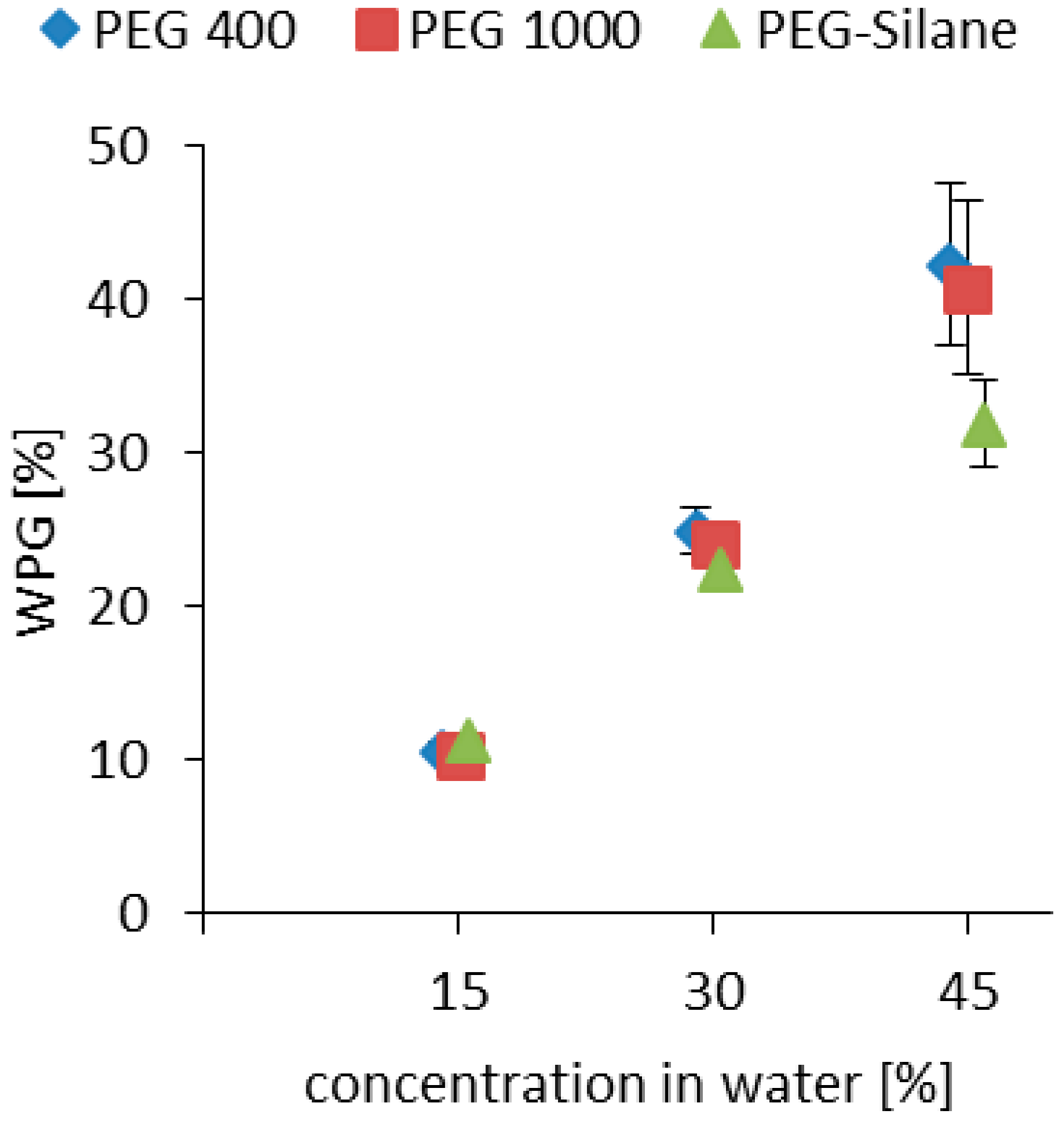
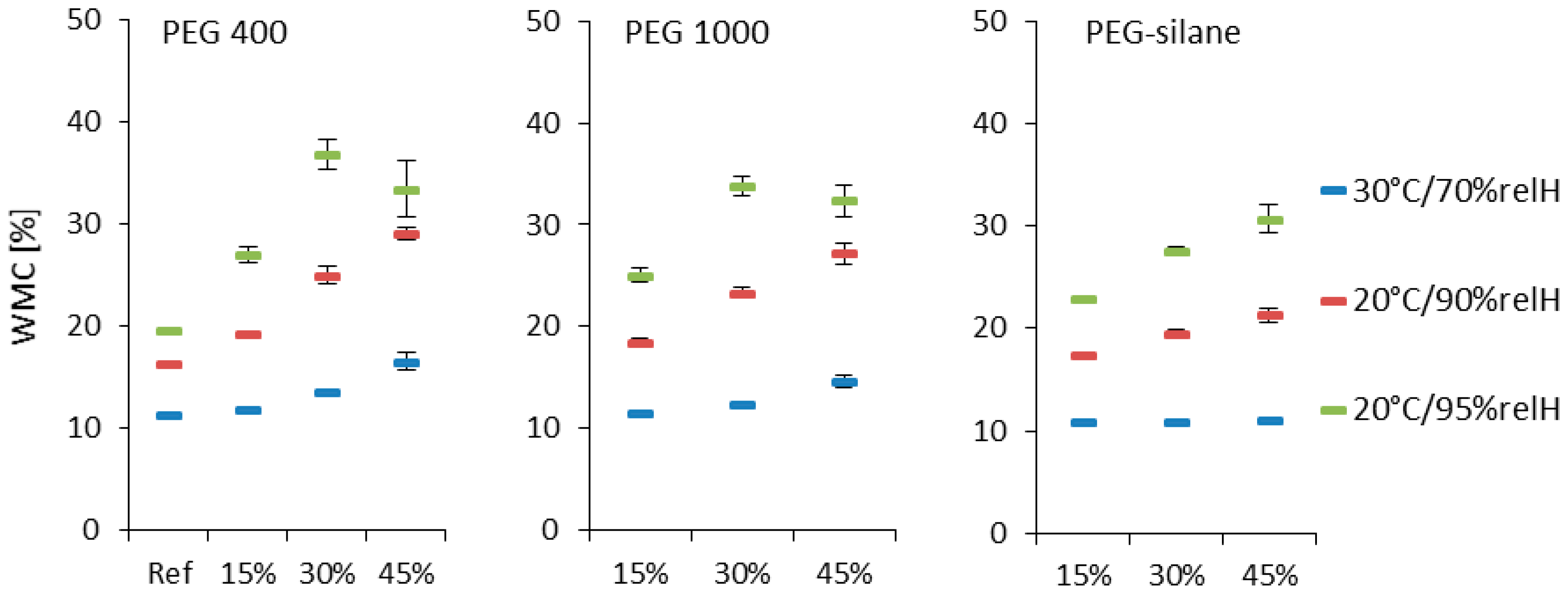
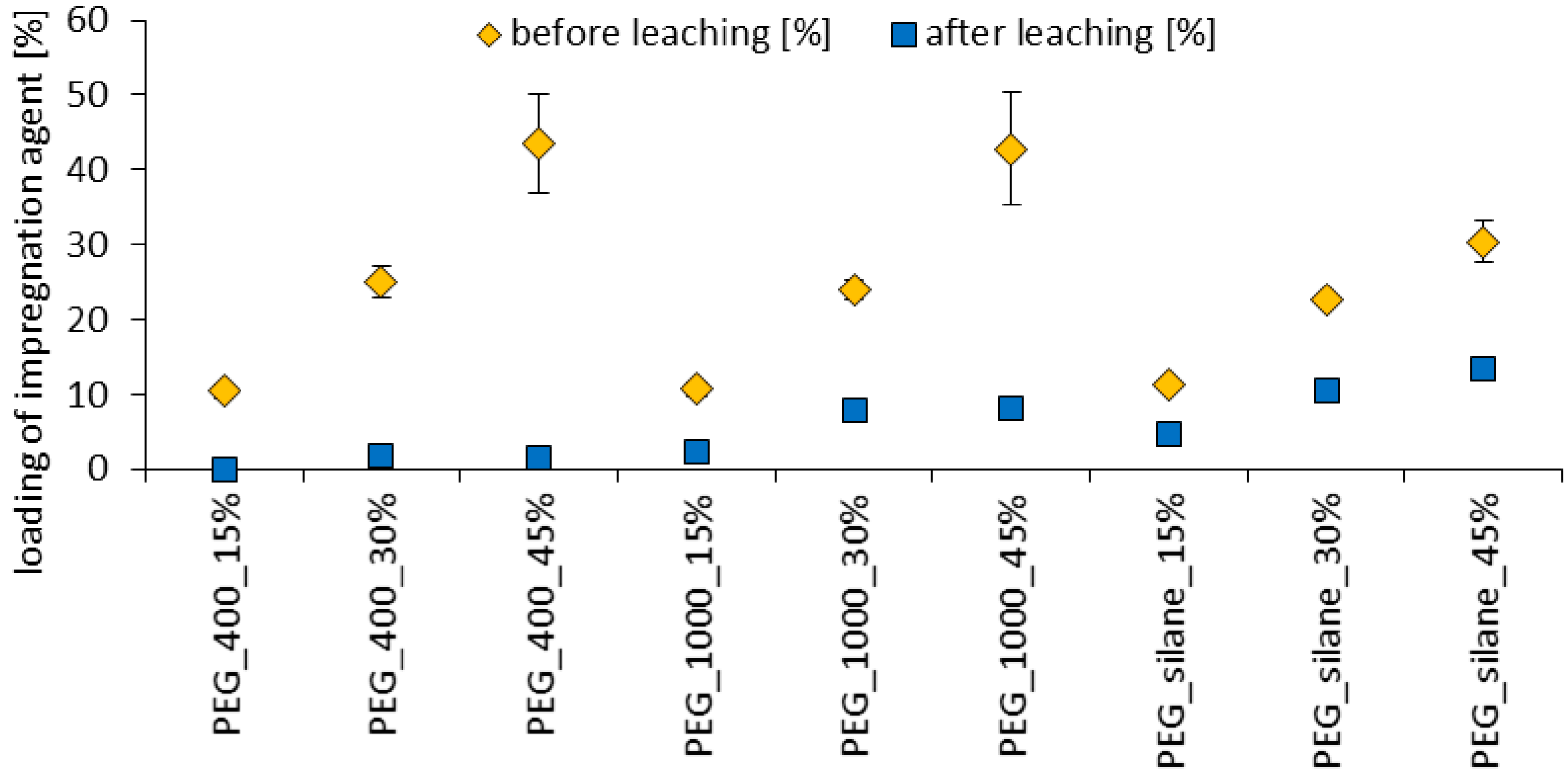
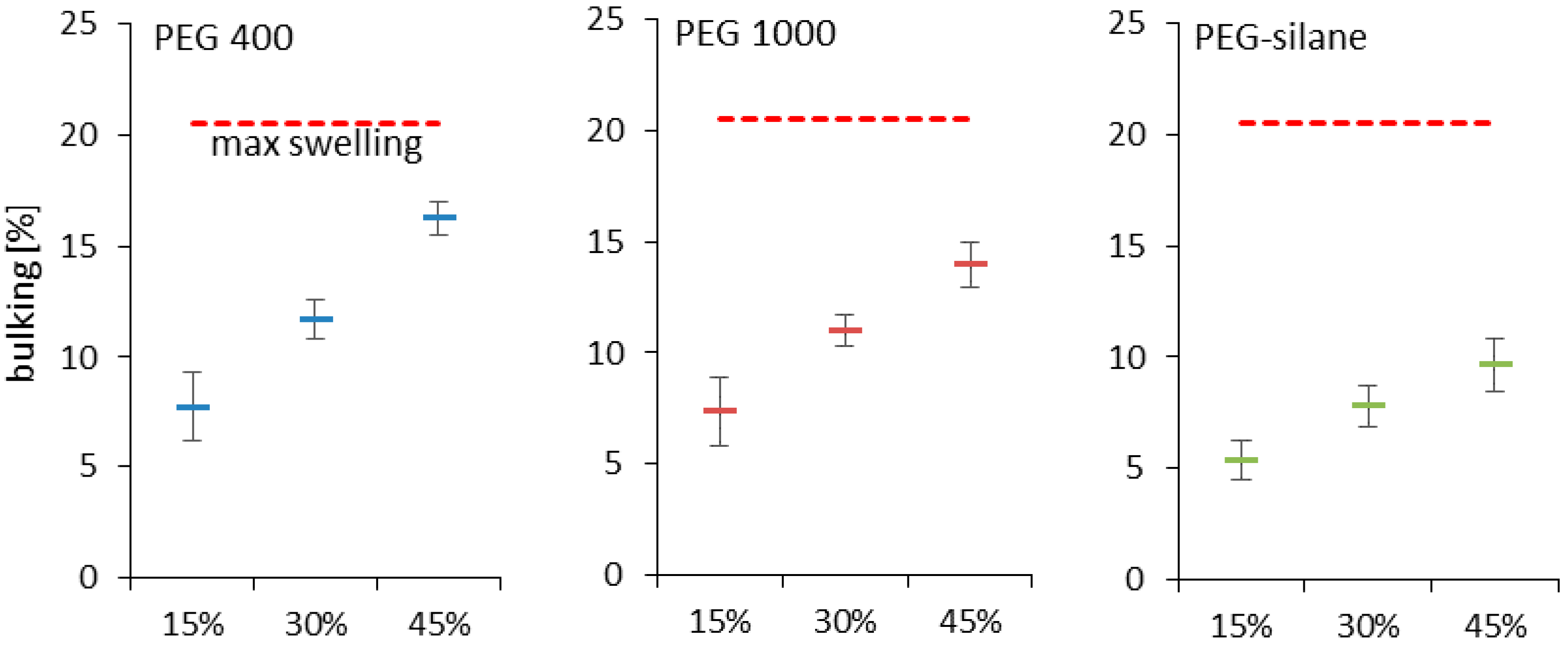

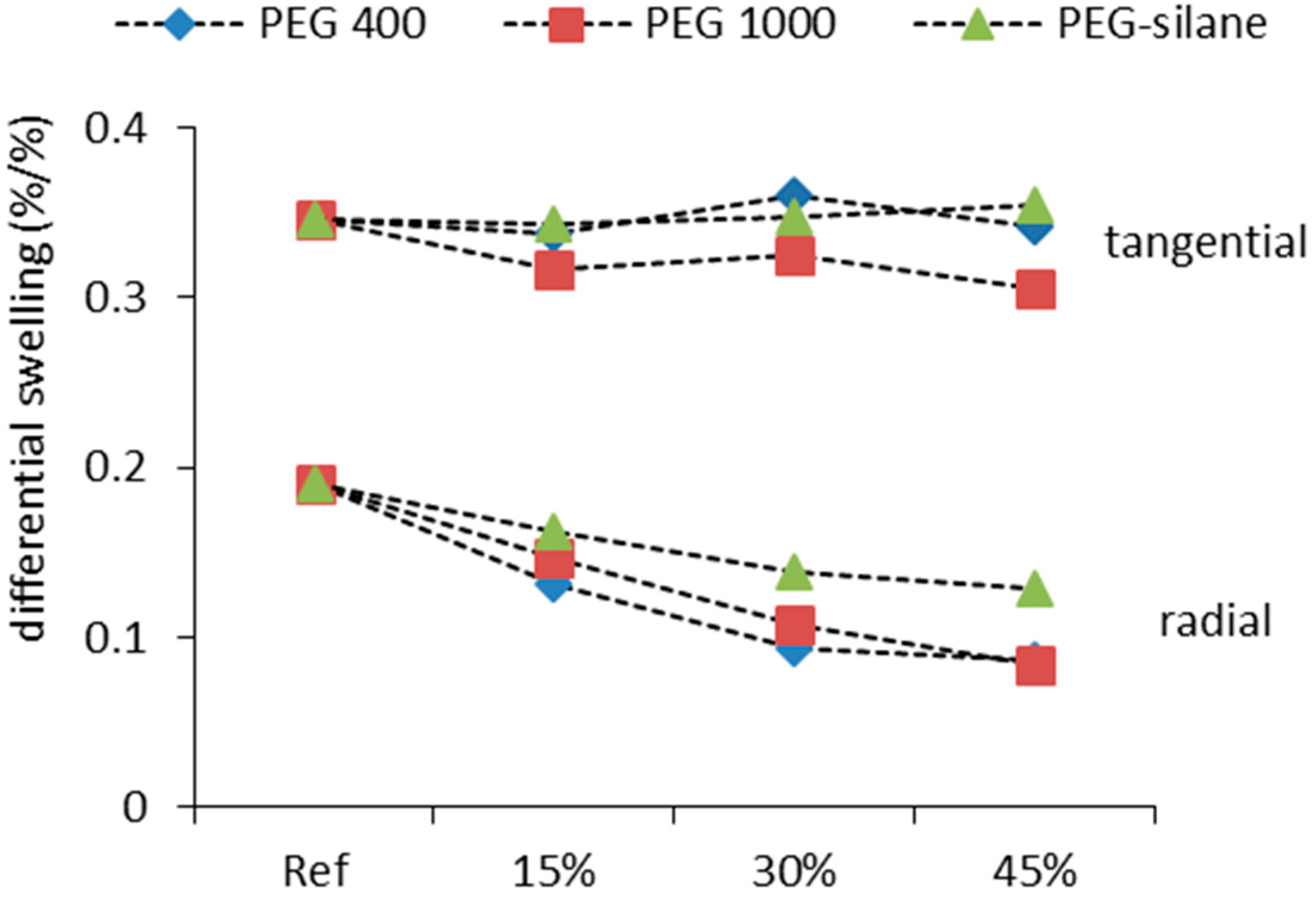

| Region | Element | at % |
|---|---|---|
| Wood ray | C | 59.46 |
| O | 40.54 | |
| Si | - | |
| Late wood | C | 59.42 |
| O | 38.59 | |
| Si | 1.99 | |
| Early wood | C | 60.65 |
| O | 36.70 | |
| Si | 2.65 |
© 2018 by the authors. Licensee MDPI, Basel, Switzerland. This article is an open access article distributed under the terms and conditions of the Creative Commons Attribution (CC BY) license (http://creativecommons.org/licenses/by/4.0/).
Share and Cite
Meints, T.; Hansmann, C.; Gindl-Altmutter, W. Suitability of Different Variants of Polyethylene Glycol Impregnation for the Dimensional Stabilization of Oak Wood. Polymers 2018, 10, 81. https://doi.org/10.3390/polym10010081
Meints T, Hansmann C, Gindl-Altmutter W. Suitability of Different Variants of Polyethylene Glycol Impregnation for the Dimensional Stabilization of Oak Wood. Polymers. 2018; 10(1):81. https://doi.org/10.3390/polym10010081
Chicago/Turabian StyleMeints, Tillmann, Christan Hansmann, and Wolfgang Gindl-Altmutter. 2018. "Suitability of Different Variants of Polyethylene Glycol Impregnation for the Dimensional Stabilization of Oak Wood" Polymers 10, no. 1: 81. https://doi.org/10.3390/polym10010081




